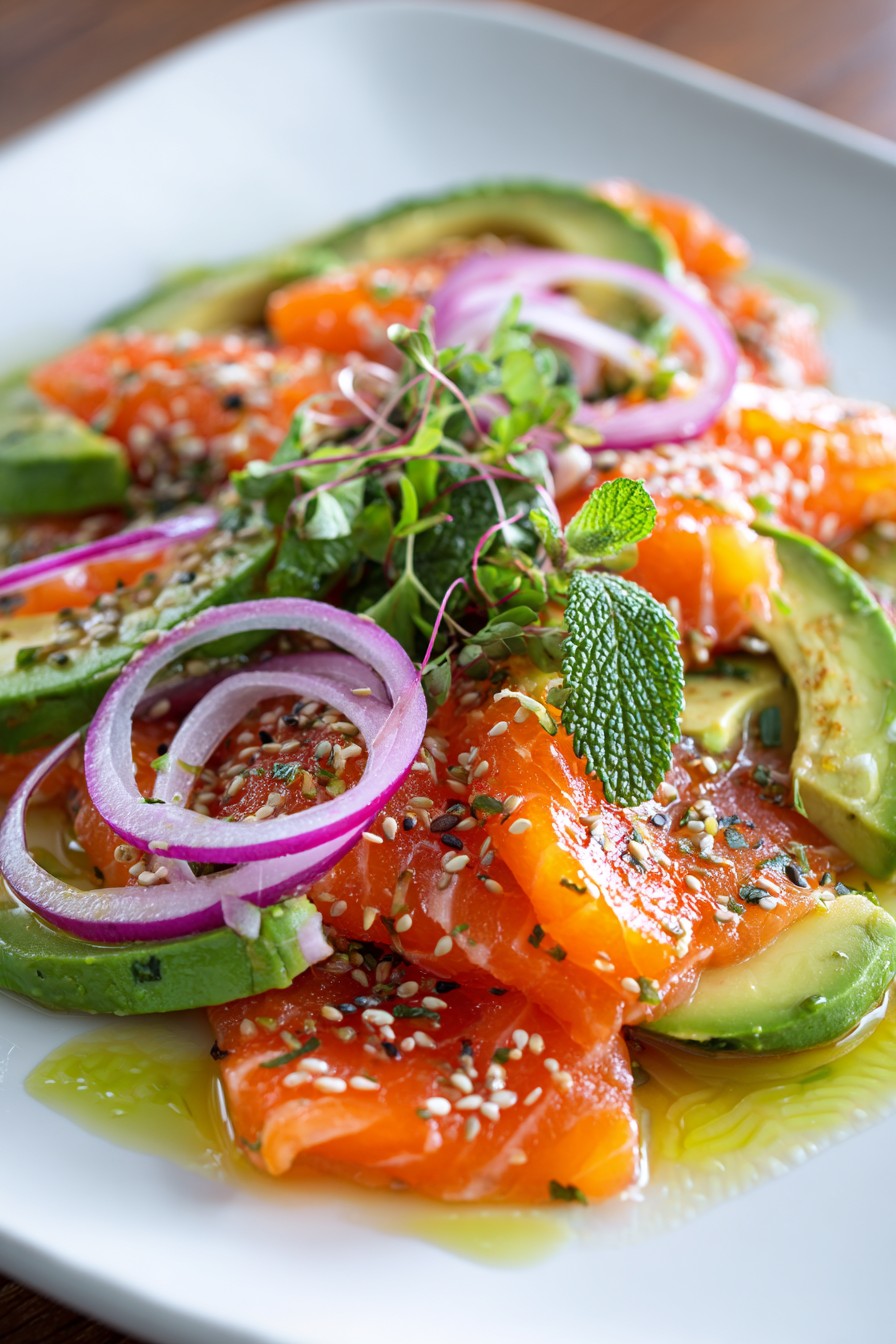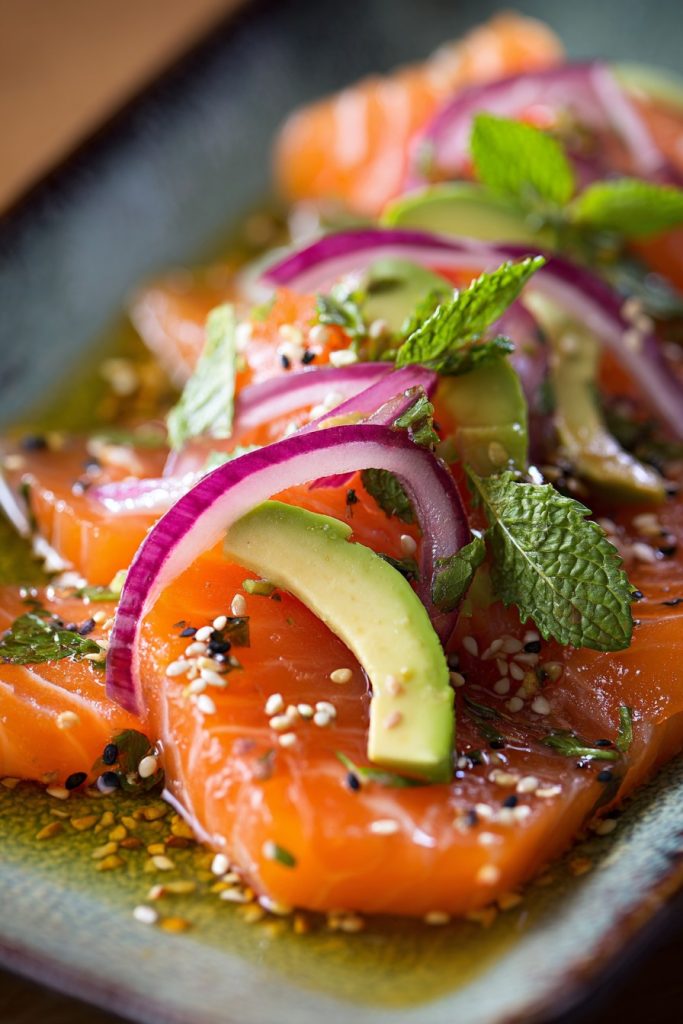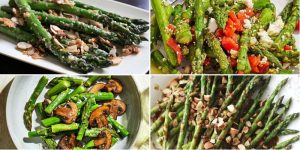Here’s a vibrant, health-forward take on tiradito de salmon that brings Peruvian coastal flavors to your kitchen with exceptional nutritional benefits. Hailing from Peru’s fusion cuisine tradition, this dish combines the omega-3 richness of fresh salmon with zesty citrus marinades and anti-inflammatory spices for a meal that’s as nourishing as it is delicious. Health-conscious eaters will appreciate how this recipe transforms raw fish into a complete, balanced dish packed with protein, healthy fats, and antioxidant-rich ingredients.
Why This Recipe Works
- The combination of fresh salmon and citrus juice creates a natural ceviche-style preparation where the acid gently “cooks” the fish without heat, preserving delicate omega-3 fatty acids and protein integrity while eliminating the need for added oils or high-temperature cooking methods that can degrade nutritional quality.
- Using a mandoline slicer ensures uniformly thin salmon slices that maximize surface area for even marination and optimal texture, allowing the fish to absorb flavors thoroughly while maintaining a silky, melt-in-your-mouth consistency that’s easier to digest than thicker cuts of raw fish.
- The strategic layering of ingredients builds complexity while supporting digestive health – ginger and garlic provide anti-inflammatory compounds, chili offers metabolism-boosting capsaicin, and fresh herbs contribute antioxidants without overwhelming the delicate salmon flavor profile.
- This preparation method requires no actual cooking, making it perfect for warm weather meals while preserving heat-sensitive nutrients like vitamin D and B vitamins that can be diminished through traditional cooking methods, offering maximum nutritional retention.
- The recipe incorporates healthy fat sources through both the salmon itself and optional avocado garnish, creating a balanced macronutrient profile that supports sustained energy release and optimal absorption of fat-soluble vitamins present in the dish.
Ingredients
- 1 pound fresh, sushi-grade salmon fillet (skin removed)
- 1/2 cup freshly squeezed lime juice (from about 4-5 medium limes)
- 1/4 cup freshly squeezed lemon juice (from about 2 medium lemons)
- 2 tablespoons orange juice (freshly squeezed)
- 1 medium red onion (thinly sliced)
- 2 cloves garlic (minced)
- 1 tablespoon fresh ginger (finely grated)
- 1-2 fresh ají amarillo peppers or serrano peppers (seeds removed, finely minced)
- 1/4 cup fresh cilantro leaves (chopped)
- 2 tablespoons fresh mint leaves (chopped)
- 1 teaspoon sea salt
- 1/2 teaspoon freshly ground black pepper
- 1 medium avocado (sliced, for garnish)
- 1 tablespoon extra virgin olive oil (for drizzling)
- 1 tablespoon toasted sesame seeds (for garnish)
Equipment Needed
- Sharp chef’s knife
- Cutting board
- Mandoline slicer (recommended) or very sharp slicing knife
- Medium mixing bowl
- Small mixing bowl
- Measuring cups and spoons
- Juicer or citrus reamer
- Microplane or fine grater
- Serving platter
Instructions

Prepare the Salmon with Precision Cutting
Begin by ensuring your salmon is completely chilled – this firmens the flesh for cleaner slicing. Place the 1-pound sushi-grade salmon fillet on your cutting board and carefully remove any remaining pin bones using clean tweezers or fish bone pliers. Using a mandoline slicer set to 1/8-inch thickness or your sharpest knife held at a 45-degree angle, slice the salmon against the grain into uniform, paper-thin slices. Arrange these slices in a single layer on your serving platter, slightly overlapping them for visual appeal. This precise cutting technique is crucial because thinner slices allow for more efficient marination and better texture. The cold temperature maintains fish integrity during slicing, and working against the grain ensures each piece will have that characteristic melt-in-your-mouth quality that defines excellent tiradito. Proper slicing also maximizes the surface area exposed to the citrus marinade, which helps naturally “cook” the fish through denaturation while preserving the delicate cellular structure that contains valuable omega-3 fatty acids.
Create the Nutrient-Dense Citrus Marinade
In your medium mixing bowl, combine the 1/2 cup fresh lime juice, 1/4 cup lemon juice, and 2 tablespoons orange juice – this citrus blend provides both acidity for the curing process and a spectrum of vitamin C. Add the 2 minced garlic cloves, which offer allicin compounds with potential cardiovascular benefits, and 1 tablespoon of finely grated fresh ginger, known for its anti-inflammatory gingerol content. Incorporate 1-2 finely minced ají amarillo or serrano peppers (adjust based on your heat preference), which contribute metabolism-boosting capsaicin. Whisk these ingredients together vigorously for about 30 seconds until well combined, then stir in 1 teaspoon sea salt and 1/2 teaspoon freshly ground black pepper. The salt helps draw moisture from the fish while the pepper adds subtle warmth. This marinade base not only flavors the salmon but creates an acidic environment that naturally preserves the fish while making its proteins more bioavailable. The combination of citrus juices provides enzymatic action that gently denatures the salmon proteins without the nutrient loss associated with heat cooking.
Marinate the Salmon for Optimal Texture
Carefully pour about two-thirds of the citrus marinade evenly over the arranged salmon slices, ensuring each piece receives some coverage while reserving the remaining marinade for final adjustment. The salmon will immediately begin to change color and opacity around the edges – this visual cue indicates the acid is properly denaturing the proteins. Let the salmon marinate at room temperature for exactly 8-10 minutes, during which time the edges will become opaque while the centers remain slightly translucent. This specific timing is crucial because shorter marination won’t properly “cook” the fish, while longer exposure can make the texture rubbery and diminish the delicate flavor. The room temperature marination allows for optimal enzymatic activity without risking bacterial growth. Watch for the salmon to transform from completely translucent to about 60-70% opaque – this visual indicator ensures perfect texture development while preserving the nutritional integrity of the raw center portions that contain heat-sensitive nutrients.
Prepare and Add the Aromatic Vegetables
While the salmon marinates, thinly slice your medium red onion using your mandoline or sharp knife – the thin slices will provide crisp texture and flavonoid antioxidants without overwhelming the dish. In your small mixing bowl, combine the sliced red onion with 1/4 cup chopped fresh cilantro and 2 tablespoons chopped fresh mint – these herbs contribute digestive enzymes and additional antioxidants. Gently toss these aromatics with the reserved one-third of the citrus marinade, allowing them to slightly soften and absorb the bright flavors. After the salmon has marinated for the designated 8-10 minutes, scatter this aromatic mixture evenly over the fish. The timing here is important because adding the vegetables too early would make them limp, while adding them after plating ensures they maintain their crisp texture and fresh flavor profile. The combination provides prebiotic fibers from the onion and various phytochemicals from the herbs that complement the salmon’s nutritional profile.
Final Assembly and Garnish for Balanced Nutrition
Artistically arrange 1 sliced medium avocado around the perimeter of your tiradito – this adds healthy monounsaturated fats that help absorb fat-soluble vitamins from the salmon. Drizzle 1 tablespoon of extra virgin olive oil over the entire dish, which contributes additional heart-healthy fats and antioxidants. Sprinkle 1 tablespoon of toasted sesame seeds across the top for crunch and additional minerals like calcium and magnesium. The avocado provides creaminess that balances the citrus acidity, while the olive oil enhances flavor absorption of the fat-soluble vitamins present in the salmon. Let the completed dish rest for 2-3 minutes before serving to allow the flavors to meld while maintaining the ideal texture of the fish. This final resting period allows the various components to integrate while ensuring the salmon doesn’t become over-marinated, preserving both the delicate texture and nutritional value of this health-forward preparation.
Tips and Tricks
Selecting the highest quality salmon is paramount for both safety and flavor in tiradito. Look for sushi-grade salmon that has been previously frozen to -4°F for at least 7 days, which eliminates potential parasites while maintaining freshness. The fish should appear vibrant in color with firm flesh that springs back when pressed gently – avoid any salmon with dull coloring, gaping flesh, or strong fishy odor. When working with citrus, always juice fruits at room temperature as they yield more juice, and roll them firmly on your countertop before cutting to maximize extraction. For those monitoring sodium intake, you can reduce the sea salt to 3/4 teaspoon and supplement with a pinch of citrus zest, which enhances perception of saltiness without additional sodium. If you cannot find ají amarillo peppers, substitute with a combination of serrano pepper for heat and a small amount of yellow bell pepper for color and slight sweetness. For optimal food safety, maintain all ingredients at proper temperatures – keep the salmon refrigerated until moment of preparation and never leave the finished dish at room temperature for more than 30 minutes. When slicing the salmon, if you don’t have a mandoline, partially freeze the fish for 15-20 minutes to firm it up for cleaner knife cuts. The marination time can be adjusted based on salmon thickness – for slightly thicker cuts (up to 1/4 inch), extend to 12 minutes, but never exceed 15 minutes as the texture will become unpleasantly firm. For those with sensitive digestion, you can briefly blanch the red onion slices in boiling water for 15 seconds then shock in ice water to mellow their intensity while maintaining crunch. The olive oil drizzle isn’t just for flavor – it creates a protective layer that helps slow additional marination once served, preserving the perfect texture longer. If preparing in advance, you can mix the marinade and prepare vegetables ahead, but only assemble the complete dish within 15 minutes of serving to maintain ideal texture and food safety standards.
Recipe Variations
- For a tropical twist that incorporates additional vitamins and enzymes, replace the orange juice with fresh passion fruit juice and add 1/4 cup of finely diced mango. The passion fruit provides digestive enzymes like bromelain while the mango contributes vitamin A and additional fiber. Include 1 tablespoon of finely chopped macadamia nuts for crunch and healthy monounsaturated fats that complement the tropical flavors. This variation maintains the health-forward approach while introducing different micronutrient profiles and natural sweetness that balances the citrus acidity beautifully.
- Create an Asian-inspired version by substituting the lime juice with yuzu juice if available, or additional lemon juice with a teaspoon of rice vinegar. Replace the ají amarillo with 1 teaspoon of sambal oelek or gochujang for fermented probiotic benefits, and add 1 tablespoon of tamari instead of salt for umami depth. Garnish with sliced scallions and toasted coconut flakes instead of sesame seeds for different texture and flavor dimensions while maintaining the nutritional integrity of the dish with these gut-healthy fermented elements.
- For a completely different protein option while maintaining similar preparation methods, use ultra-fresh sea scallops sliced horizontally into thin rounds. The marinade time reduces to 5-6 minutes maximum since scallops firm up more quickly. Add 1 tablespoon of finely chopped nori seaweed to the garnish for iodine and mineral content, and include thinly sliced radishes for additional crunch and detoxifying compounds. This variation provides similar nutritional benefits with different texture and flavor profiles that appeal to those who may prefer mollusks over fish.
- Transform this into a vegetarian option using very firm ripe peaches or nectarines sliced paper-thin. The citrus marinade will slightly soften the fruit similarly to how it affects fish proteins. Add 1/4 cup of crumbled queso fresco or vegan feta for protein, and include 2 tablespoons of pumpkin seeds for healthy fats and zinc. This creative approach maintains the visual appeal and preparation technique while offering a completely plant-based alternative that still provides substantial nutritional value through different mechanisms.
Frequently Asked Questions
Is it safe to eat raw salmon in this preparation?
When proper precautions are taken, consuming raw salmon in tiradito is generally safe for healthy individuals. The key is using sushi-grade salmon that has been previously frozen to -4°F for at least 7 days, which effectively eliminates potential parasites. The acidic marinade creates an environment that further inhibits bacterial growth, though it doesn’t completely sterilize the fish. Those with compromised immune systems, pregnant individuals, or young children should consult healthcare providers before consuming raw fish preparations. Always purchase from reputable fishmongers who specialize in sushi-grade products and maintain proper refrigeration throughout transport and preparation to ensure optimal food safety standards are met.
Can I make this dish ahead of time for entertaining?
Tiradito is best prepared fresh, but you can complete most components in advance to streamline final assembly. The citrus marinade can be prepared up to 2 hours ahead and refrigerated, while vegetables can be sliced and herbs chopped several hours in advance. However, the actual marination should occur no more than 15 minutes before serving to maintain ideal texture. For entertaining, have all components pre-measured and arranged, then complete the final assembly just before guests arrive. The salmon itself should be sliced immediately before marinating, as pre-slicing can cause oxidation and texture changes that diminish both quality and nutritional value of this delicate preparation.
What are the main nutritional benefits of this tiradito recipe?
This preparation offers exceptional nutritional advantages through multiple mechanisms. The salmon provides high-quality complete protein and omega-3 fatty acids EPA and DHA, which support brain health, reduce inflammation, and promote cardiovascular function. The citrus juices contribute significant vitamin C, which enhances iron absorption from the fish and acts as a powerful antioxidant. Fresh herbs like cilantro and mint provide digestive enzymes and various phytochemicals, while garlic and ginger offer anti-inflammatory compounds. Because the fish isn’t heated, heat-sensitive nutrients like certain B vitamins remain intact, and the healthy fats from both salmon and avocado support absorption of fat-soluble vitamins. This combination creates a nutrient-dense meal that’s both satisfying and exceptionally health-supportive.
How can I adjust the spice level for different preferences?
Controlling heat is simple while maintaining the dish’s nutritional profile. For milder versions, use only 1/2 pepper and remove all seeds and membranes where capsaicin concentrates. For medium heat, use one whole pepper with seeds removed. For maximum spice, include 2 peppers with some seeds. You can also substitute different pepper varieties – jalapeños provide milder heat than serranos, while habaneros offer floral notes with intense heat. Remember that capsaicin provides metabolism-boosting benefits, so including some level of spice supports nutritional goals. Always taste your peppers first, as heat levels can vary significantly even within the same variety, and adjust accordingly to suit your preferences while maintaining the health benefits.
What are the best side dishes to serve with tiradito?
Tiradito pairs beautifully with sides that complement its bright flavors and nutritional profile. Steamed quinoa provides complete protein and fiber without overwhelming the delicate fish, while roasted sweet potatoes offer beta-carotene and complex carbohydrates. A simple salad of butter lettuce with a light citrus vinaigrette adds crunch and additional vitamins without competing flavors. For traditional accompaniments, toasted corn nuts provide texture and minerals, while boiled Peruvian corn offers subtle sweetness and fiber. Avoid heavy, creamy sides that would mask the tiradito’s delicate balance, and instead focus on light, nutrient-dense options that enhance rather than dominate the main dish’s health-forward characteristics and flavor complexity.
Summary
This health-conscious tiradito de salmon combines Peruvian flavors with exceptional nutrition through precise preparation techniques that preserve delicate omega-3s and heat-sensitive vitamins. The citrus-marinated salmon delivers high-quality protein alongside antioxidant-rich ingredients, creating a balanced dish that supports cardiovascular and digestive health while offering vibrant, restaurant-quality presentation perfect for nutritious entertaining.



